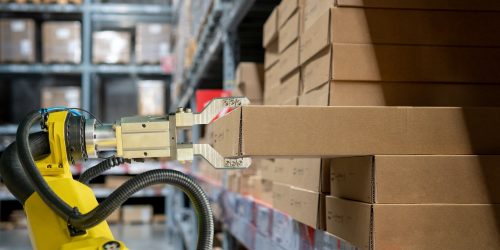Big data and AI, growth drivers of the Green Supply Chain
Combined with artificial intelligence (AI), big data is an essential work tool for developing the Green Supply Chain on a large scale. The goal is, of course, to achieve carbon neutrality within the supply chain, without compromising on performance.
According to a study conducted by Capgemini in August 20201, 85% of companies believe that it is possible to combine cost optimisation with environmental protection. It is a strategic priority, responding to a real demand from customers. According to the same study, 79% of consumers now consider the environmental impact of their purchases.
Big data and AI structure the Green Supply Chain
Ecological and digital transitions go hand in hand. They are on the same roadmap and meet the same operational and environmental performance objectives with a focus on cost optimisation.
How does technology serve the environment?
Digital technologies can increase the resilience and performance of the Supply Chain while reducing its carbon footprint. Fuel and energy savings, waste reduction, and increased time and efficiency are all possible thanks to real-time data collection and processing systems.
According to the study cited above, almost 80% of companies plan to invest in digital technologies to accelerate their ecological transition, for example by switching to the automated Warehouse 4.0. They consider this potential investment as follows:
- For 59% of them, data collection and analysis systems provide valuable indicators for the management and control of environmental issues (consumption of energy, fuel and water, as well as CO2 emissions).
- 50% also consider that technological progress increases the accuracy of these indicators.
Artificial intelligence to reduce the environmental cost of road transport
Road transport has access to concrete solutions thanks to big data and artificial intelligence. Real-time data collection provides a wealth of information on the way in which drivers drive and thus on fuel consumption. Through the data analytics, it is possible to educate drivers on how to drive in a more energy-efficient way and therefore reduce CO2 emissions.
The main assets of using big data and artificial intelligence in the road transport sector are as follows:
- Reduced transport costs;
- Reduced environmental footprint of the supply chain;
- Drivers often drive more carefully.
Big data also reduces delivery times by optimising routes and refuelling. Real-time traffic analysis makes it possible to always select the most efficient route and to reduce the number of trips. It is estimated that these tools reduce travel distances by 16% and increase the punctuality of deliveries to an average of 98%. A step forward for both CSR and customer satisfaction.
When artificial intelligence and Supply Chain mean predictability
The other great benefits of big data, when combined with artificial intelligence (AI) software and processed by learning algorithms (Deep Learning), lies in its analytical capacity. Companies are therefore shifting from an analysis model based on past performance to one that can inform on potential future events. Adapted to logistics, this predictive functionality provides the Supply Chain with effective solutions, both operationally and environmentally.
For instance, this choice was made by the port of Antwerp, through the creation of a 3D model of the port called APICA (Antwerp Port Information and Control Assistant). The modelling is made possible by the processing of real-time data that synthesizes all the activity of the port. It considers the following data:
- Movement of goods;
- Weather conditions;
- Air quality;
- Tides;
- Staff availability;
- Movements of bridges and locks.
All this data is transmitted by IoT (Internet of Things) sensors, cameras, and drones. This gives port managers a comprehensive view of activity in real time, which enables them to foresee unusual situations. This makes it possible, for example, to predict the toxicity of ship emissions in different circumstances and to take appropriate corrective action.
The predictability provided by data and artificial intelligence in the Supply Chain is also a solution to drastically reduce waste, especially in the transport of fresh products. It is estimated that the ability to adjust stocks and loads in advance as closely as possible to sales can reduce the number of lorries on the road by 15-20%. The quality of forecasts increases by 10 to 15 points thanks to AI.
Big data and artificial intelligence transform the Supply Chain
To be able to reduce their environmental impact, optimise their interactions and respond to disruptions in real time, companies must have full control of their supply chain.
Why collect data across the product life cycle?
Companies need a more comprehensive view of the materials, components and ingredients used, packaging, sourcing, production processes and energy consumption. This comprehensive view of their business provides them with the necessary resources to make profound changes to the industry’s supply chain.
Companies also need to build intelligent networks that include the different players in their market, starting with their customers. This allows them to access data on the distribution and recycling of their items. Artificial intelligence models designed for the Supply Chain and ML (Machine Learning) are essential in making this data usable.
Towards transparency of the Supply Chain to better understand its challenges
Establishing an effective monitoring and tracking computer process requires the creation of a network of companies who share information. To fully understand the challenges of reducing the environmental impact of production, a business needs to create links with its direct and indirect suppliers. This network can also include sources such as satellites to monitor deforestation, water exploitation, agriculture, and mining.
Technologies such as Blockchain, 5G and sensors on pallets also help to provide secure, real-time connectivity. These tools also provide visibility on holding chains and network interactions. Collecting and managing all this information requires a scalable data lake and the integration of many data sources.
Artificial Intelligence in the Supply Chain and in the Warehouse
Technology has brought the warehouse into the 4.0 era. The warehouse management of tomorrow is optimised by the combined use of automation, artificial intelligence, and big data processing. These technological advances make it possible to act in favour of the ecological transition by improving all warehouse processes. This optimisation of the warehouse leads to changes in the teams’ management, which in turn leads to new organisation of services and changes in management.
Download our white paper on “The transformation of the warehouse and its operations” to better understand the new human challenges of this sector.





